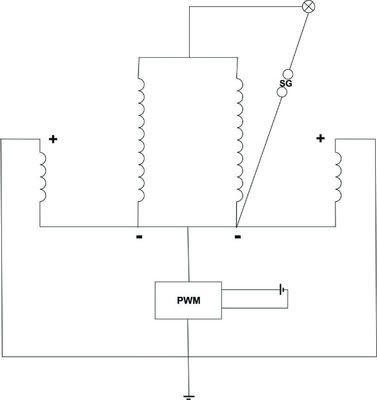Thanks! zilano! Can anybody read Russian? I'll try it at our secretary. She claims to have learned Russion while living in the former German "democratic" Republic. But she has no technical knowledge at all. Perhaps she can transfer it in normal text in order to crank it through google translator.
Can anybody read Russian? I'll try it at our secretary. She claims to have learned Russion while living in the former German "democratic" Republic. But she has no technical knowledge at all. Perhaps she can transfer it in normal text in order to crank it through google translator.
My personal notion regarding schematic function (comments welcome):
A: Middle bottom of schematic
1. Transformer (Tp3) from obviously 50 Hz 220V to some lower voltage DC. Let's suppose somewhere between 12V and 24V.
2. Switch for start / stop in the DC power line
B: Left hand side
1. Higher frequency oscillator Meissner type (corresponds to JT)
2. Transistors work push/pull towards an artificial middle voltage C3/C4. This saves additional 2 Transistors in order to build a true H-Bridge. (BTW: Stepper motor drivers use cheap H-Bridges up to 40V/ 3.5 A i.e. TB6560AHQ)
3. Meissner transformer 40/40 turns (Tp1) (Air core? / Ferrite?)
C: Middle of schematic (bridge betwen transformer Tp1 and Tp2 and Tp3)
1. On same core from above core: harvest coil with middle connector. 120 turn (1x 120 or 2x120?) (cw/ccw?)
2. Connected to harvest coils there is a normal 220V/50Hz transformer for low voltage (see A
3. Transformer connected via 2 capcitors c5 c6
4. Power output after C5/C6 with 220 V switch
5. Output with earth connection (safety or essential?)
Discussion:
This normally should be a high frequency output. Don Smith prefers his (for me) not understandbale "frequency scale down" resistor. Russians seem to prefer a more understandbale version. They modulate the high frequency by another 50 Hz transformer (Tp3). I'm not completely clear about this. Comments welcome!
D: Right hand side
1. Another Oscillator of Meissner type. (50Hz?) adjustable
2. Transformer Tp3 / Transformer with (Iron core?)
3. Output coils with spark gap (seems to modulate high frequency)
4. Earth connection. (individual or same as 220V output? / safety?/functional?/ essential?)
Discussion: Not celar how this modulation works along with this spark gap.
@Zilano: I understand your words regarding cold and hot. But my heart is not open to understand. I need to learn alot! And I understand that knowledge needs more than one way in order to be received.
And I understand that knowledge needs more than one way in order to be received.
rgds John
 Can anybody read Russian? I'll try it at our secretary. She claims to have learned Russion while living in the former German "democratic" Republic. But she has no technical knowledge at all. Perhaps she can transfer it in normal text in order to crank it through google translator.
Can anybody read Russian? I'll try it at our secretary. She claims to have learned Russion while living in the former German "democratic" Republic. But she has no technical knowledge at all. Perhaps she can transfer it in normal text in order to crank it through google translator.My personal notion regarding schematic function (comments welcome):
A: Middle bottom of schematic
1. Transformer (Tp3) from obviously 50 Hz 220V to some lower voltage DC. Let's suppose somewhere between 12V and 24V.
2. Switch for start / stop in the DC power line
B: Left hand side
1. Higher frequency oscillator Meissner type (corresponds to JT)
2. Transistors work push/pull towards an artificial middle voltage C3/C4. This saves additional 2 Transistors in order to build a true H-Bridge. (BTW: Stepper motor drivers use cheap H-Bridges up to 40V/ 3.5 A i.e. TB6560AHQ)
3. Meissner transformer 40/40 turns (Tp1) (Air core? / Ferrite?)
C: Middle of schematic (bridge betwen transformer Tp1 and Tp2 and Tp3)
1. On same core from above core: harvest coil with middle connector. 120 turn (1x 120 or 2x120?) (cw/ccw?)
2. Connected to harvest coils there is a normal 220V/50Hz transformer for low voltage (see A

3. Transformer connected via 2 capcitors c5 c6
4. Power output after C5/C6 with 220 V switch
5. Output with earth connection (safety or essential?)
Discussion:
This normally should be a high frequency output. Don Smith prefers his (for me) not understandbale "frequency scale down" resistor. Russians seem to prefer a more understandbale version. They modulate the high frequency by another 50 Hz transformer (Tp3). I'm not completely clear about this. Comments welcome!
D: Right hand side
1. Another Oscillator of Meissner type. (50Hz?) adjustable
2. Transformer Tp3 / Transformer with (Iron core?)
3. Output coils with spark gap (seems to modulate high frequency)
4. Earth connection. (individual or same as 220V output? / safety?/functional?/ essential?)
Discussion: Not celar how this modulation works along with this spark gap.
@Zilano: I understand your words regarding cold and hot. But my heart is not open to understand. I need to learn alot!
 And I understand that knowledge needs more than one way in order to be received.
And I understand that knowledge needs more than one way in order to be received.rgds John
 nd a diode after spark gap.
nd a diode after spark gap.







Comment